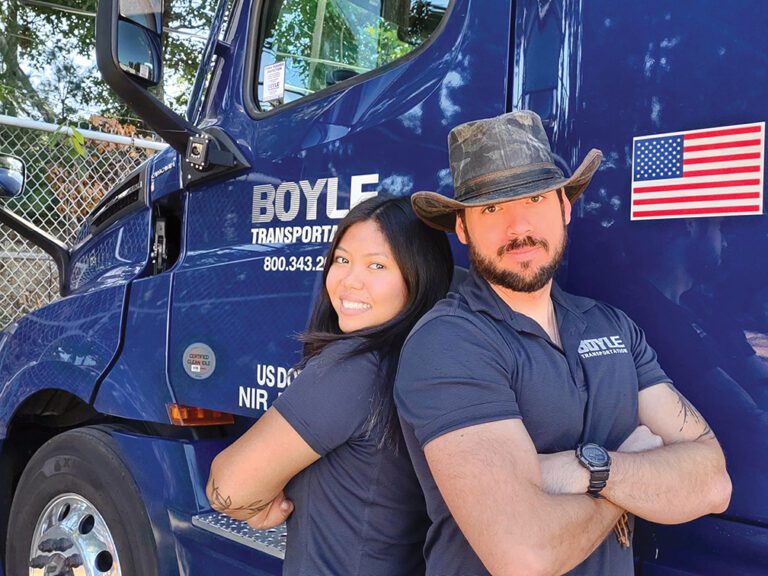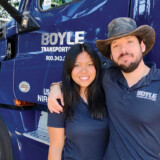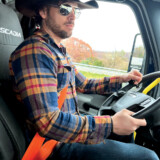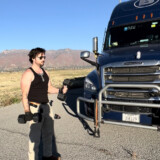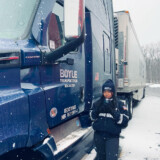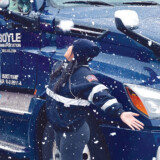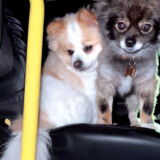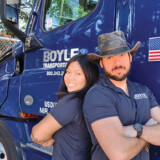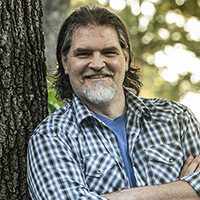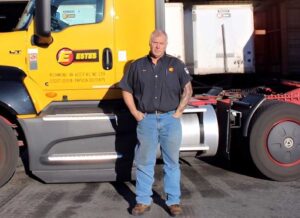Every winning team takes the best traits of each member and combines them in a way that rounds out the whole picture. In the case of Whitby Monterroso and Mary Mei Samaniego, this is especially true.
Drivers for Boyle Transportation since 2019, the husband-and-wife team share many of the same characteristics and interests, yet retain their own unique individuality while working and traveling together.
“I’m pretty sure it is hard for anybody as a couple, having this personal relationship — and now you’re co-workers,” Samaniego said. “It’s definitely very hard in the beginning but we got used to it. We communicate with each other, and now we love being together.”
The two aren’t alone on the road; they travel with a pair of canine companions.
“The best thing is that I’m with her 24/7, and we have our little puppies with us,” Monterroso said. “That’s the hardest part about being away from home — being away from your family — so with them with me, it’s perfect.
“Now, the hardest part? I would have to say it is the over-the-road living, doing your basic laundry, grocery shopping and missing all the comforts of living at your house,” he continued. “That’s the hard part.”
The two come from very different backgrounds — he’s of Hispanic descent and she was born in the Philippines — but points in common began to present themselves early, putting the pair on a collision course, so to speak. Both spent part of their youth in California before enlisting in the U.S. Army.
“We were in the same unit when we were at Fort Hood, here in Texas,” Monterroso said. “I was an NCO (non-commissioned officer), and she was the supply sergeant. We were in the same company, same unit. We just kind of saw each other and we started hanging out. We did some work-related stuff, and we got to know each other better. One thing led to another.”
By that time, Monterroso had already cut his teeth as a driver, having spent nine years of his military hitch behind the wheel of heavy vehicles both at home and abroad.
“We transport our own equipment in the Army, and in my career field, driving a truck is pretty much mandatory,” he said. “Once I started doing that and I got licensed on a specific vehicle, one thing led to another; my units kept having me get licensed on multiple different types of vehicles. I started becoming a subject-matter expert not only driving vehicles, but the large vehicles in general. I found I was pretty good at it.”
Monterroso transitioned into the trucking industry upon his discharge five years ago. When Samaniego decided to get behind the wheel, he also oversaw some of her initial training on the civilian side.
“I already had experience with driving big vehicles, so all I needed to do what take the written exam and then I was able to get my CDL license,” she said. “I was like, ‘Why not just get it?’ I was a passenger with him for two months and then I was like, ‘This is pretty good; we can definitely do this.’ We’ve been team drivers ever since.”
Driving for Boyle Transportation, the team drive reefer for the vast majority of the time. The pair is also hazmat-certified for handling specialized loads. Both say their military experience provided skills that continue to shape the way they drive.
“In my case, I learned how to drive in a multitude of environments in deployment, learning to drive fast, drive evasively and drive cautiously and be aware with my head on a swivel, always looking for stuff,” Monterroso said. “Then stateside, driving hazardous materials, I always had to have my documents and paperwork on point. When I went through haz training, I was already familiar with that.
“On top of that, being in the military, transporting my equipment, I had to learn how to tie that stuff down and load it on a flatbed,” he continued. “Going to the civilian side, I already knew all of the basics, it was just like military one day, walk through a door and I’m in the civilian world. There was really no difference.”
Samaniego says another factor is discipline.
“I think a big part of truck driving is, you’ve always got to be a defensive driver. If somebody cuts you off, what do you do? You pretty much have to press the brake and then keep the following distance,” she said. “That takes a lot of discipline sometimes, because emotions are really hard to control. When people do stupid things around you and you start getting mad, you have to be disciplined. That’s your career on the line.”
The self-discipline doesn’t stop there. Avid fitness buffs, the couple have had to learn how to adapt to working out on the road.
“We find quite a bit of time to work out,” Monterroso said. “There’s been times I’ll stop on my 30-minute break, and I work out. You just have to prioritize it.”
“As time goes on, you start figuring things out,” Samaniego added. “We started learning more about diet and nutrition and now we pretty much make sure we go grocery shopping every week to make sure we don’t eat out every day. “
The couple also discovered the value of bringing their four-legged family members along. They have two panda Pomeranians, named Plusle and Minun, that lend a sense of normalcy to life on the road.
“Having the girls with us definitely is a mood lifter,” Monterroso said. “If we’re having a stressed-out day, these girls are so damn cute! They’re like living stuffed animals. They just love attention, and they love people.”
“Just having them along helps when I’m driving,” Samaniego said. “He’s sleeping while I’m driving, and the girls sit in the passenger seat. I’m looking at them and talking to them while I’m driving, and that makes me feel better.”
The couple average about 3,000 miles a week, with runs predominantly in the northeast U.S. Samaniego says she makes good use of road time when not driving, scouring blogs and informative sites online to expand the couple’s horizons.
“We’re living in such an information age that everything you want to know is literally one click away,” she said. “Ever since I became a truck driver, I’ve learned so many different businesses. I learned how to do Airbnb. I’m a super host now because of just listening to podcasts and YouTube. I learned how to do real estate investing, and I’m learning now about trying positive mindset. And I actually found stock trading, and I’m starting to do that now.
“Without trucking, I would not have learned all this stuff because in other jobs, you just focus on the job and only the job during the day,” she continued. “In trucking you have time to listen to other things and learn other things at the same time, all the time.”
Dwain Hebda is a freelance journalist, author, editor and storyteller in Little Rock, Arkansas. In addition to The Trucker, his work appears in more than 35 publications across multiple states each year. Hebda’s writing has been awarded by the Society of Professional Journalists and a Finalist in Best Of Arkansas rankings by AY Magazine. He is president of Ya!Mule Wordsmiths, which provides editorial services to publications and companies.








